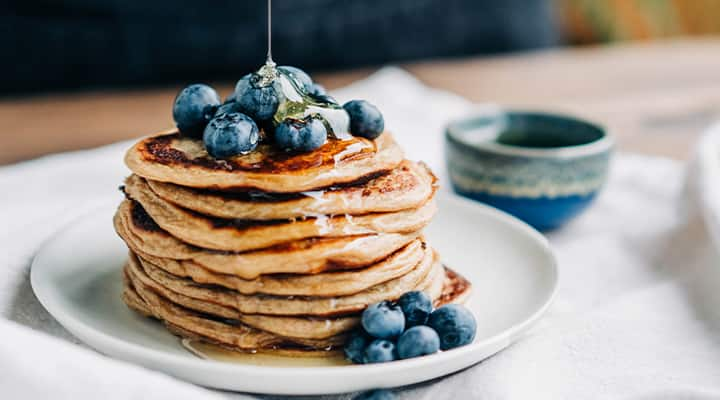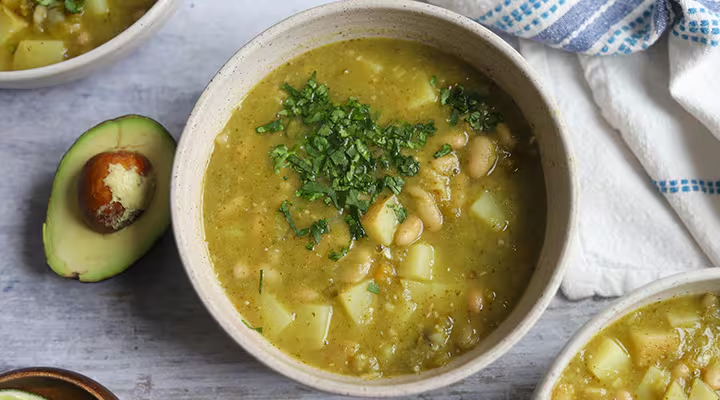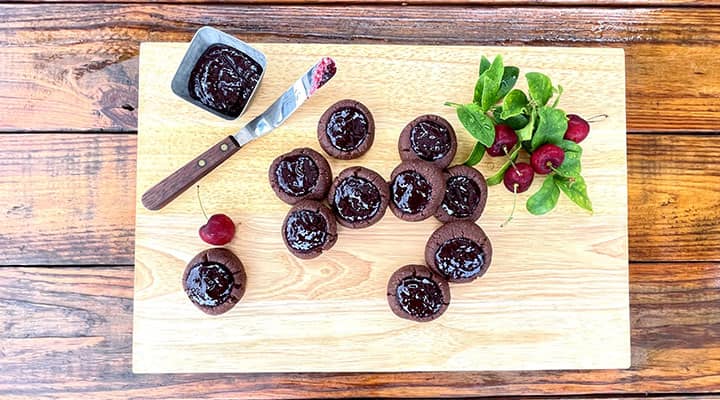
Quinoa Breakfast Bowl: A Mediterranean Staple
Published: April 2022
Want to start your day with a healthy culinary adventure? Try a breakfast bowl of quinoa in place of your traditional oatmeal in the morning. This fluffy, whole grain—packed with plant protein—is the perfect blank canvas for sweet mix-ins such as cinnamon, maple syrup, fresh fruit and creamy almond butter. Or go savory with a soft-boiled egg with stir-fried vegetables. No matter which route you take, this will become your new go-to, gluten-free healthy breakfast.
What is quinoa and why is good for you?
Though technically a seed, quinoa is considered a whole grain due to its similar nutrition profile and uses. This naturally gluten-free grain is particularly high in plant-based protein, with one cooked cup providing about 8 grams. Quinoa is also a source of the essential nutrients manganese, phosphorous, magnesium, and folate, as well as fiber.
Quinoa might not be familiar to you, but it has been on the menu in some parts of the world for a long time. Quinoa is native to the South American Andes region, and was cultivated in the region as early as 5,000 BC to 3,000 BC. It was considered a sacred food in the Inca civilization.
Can quinoa be used as a breakfast cereal?
Oatmeal gets all the "whole grain breakfast" glory, but quinoa is just as suitable an option. Whether you are craving sweet or savory, quinoa breakfast porridge is versatile and customizable. Plus, cooking your quinoa with dairy-free milk, such as almond milk or coconut milk, keeps it vegan and will enhance its texture and flavor.
How to make the best quinoa breakfast bowls
While quinoa breakfast recipes can be made in the morning on the stovetop or in an instant pot, you can also opt for make-ahead quinoa breakfast bowls to fit with your grab-and-go lifestyle. Simply double the recipes below and store in the refrigerator for a high-protein, ready-to-eat, plant-based breakfast.
Cinnamon Breakfast Quinoa Bowl
-
Serves: 2
-
Prep time: 5 minutes
-
Cook time: 20 minutes
Ingredients:
- ½ cup uncooked white quinoa
- 1 cup unsweetened non-dairy milk such as almond milk or coconut milk
- 1 tsp. cinnamon
- 2 Tbsp. maple syrup
- 1 tsp. pure vanilla extract
- Pinch of salt
Suggested toppings and mix-ins:
- Raw, roasted or spiced nuts
- Natural unsweetened nut butter such as almond butter or peanut butter
- Hemp seeds
- Unsweetened coconut flakes
- Fresh fruit like blueberries or banana
- Chia seeds
- Dark chocolate chips or cocoa powder for a chocolate quinoa breakfast bowl
- Almonds
Preparation:
- Rinse and drain the quinoa.
- Place the quinoa in a small saucepan and add almond milk (or another non-dairy option), cinnamon, maple syrup and vanilla. Place the saucepan over medium-high heat, cover and reduce the heat to low. Simmer for 10 to 15 minutes or until the quinoa has absorbed the liquid. Fluff with a fork.
- Scoop the quinoa into two serving bowls and add your toppings and mix-ins of choice. Breakfast is served!
Nutritional Value (plain without toppings):
-
Calories: 230
-
Carbohydrates: 44 g
-
Protein: 6 g
-
Fat: 4 g
All nutritional information is based on third-party calculations and is only an estimate. Each recipe and nutritional value will vary depending on the brands you use, measuring methods and portion sizes.
Explore Our Best Food & Drink Formulas
Savory Mediterranean Breakfast Quinoa Bowl
-
Serves: 2
-
Prep time: 5 minutes
-
Cook time: 20 minutes
Ingredients:
- ½ cup uncooked white quinoa
- 1 cup unsweetened non-dairy milk such as almond milk or coconut milk
- 1 Tbsp. California Estate Extra-Virgin Olive Oil
- 2 eggs
- 1 cup kale, chopped
- 1 cup cherry tomatoes, halved
- ½ medium avocado, sliced
- Salt to taste
- Red pepper flakes to taste (optional)
Preparation:
- Rinse and drain the quinoa.
- Place the quinoa in a small saucepan and add almond milk. Place the saucepan over medium-high heat, cover and reduce heat to low. Simmer for 10 to 15 minutes or until the quinoa has absorbed the liquid. Fluff with a fork and scoop the quinoa into two serving bowls.
- Warm oil in a medium skillet over medium-high heat. Add kale to the skillet and cook until tender and wilted, 2 to 3 minutes. Divide between both serving bowls.
- Prepare the eggs:
- For a fried egg: Heat a nonstick pan (or the skillet used to cook the kale) over medium heat. Crack the eggs into the pan and cook for 3 minutes or until the whites are set. Remove from the pan and season with salt. Divide between both serving bowls.
- For a soft boiled egg: Add 1 inch of water to a small saucepan, and bring to a boil over high heat. Once boiling, add the uncracked eggs. Place the lid on top and let it boil for 6 minutes. Remove the eggs from the pot and run under cool water. Peel and divide between both serving bowls.
- Divide cherry tomatoes and avocado between both serving bowls and top with red pepper flakes to taste.
Nutritional Value:
-
Calories: 336
-
Carbohydrates: 40 g
-
Protein: 15 g
-
Fat: 15 g
All nutritional information is based on third-party calculations and is only an estimate. Each recipe and nutritional value will vary depending on the brands you use, measuring methods and portion sizes.
Is quinoa gluten-free?
Yes, quinoa is naturally gluten-free. However, because multiple grains are often grown and processed together, it is wise to check if the quinoa you are purchasing is certified gluten-free to ensure no cross-contact may have occurred. This is particularly important for those watching their gluten intake.
What color of quinoa is the healthiest?
There are more than 120 known varieties of quinoa, ranging in colors, textures and nutrition. White and yellow quinoa are mildest in flavor, so these are a great starting point for those new to quinoa. Black and red quinoa have a somewhat stronger, earthier flavors. They hold their shape better than white or yellow quinoa, making them a great addition to salads or soups. No matter the color, each quinoa variety is a smart nutritional choice.
What else can you add to a quinoa bowl?
Because quinoa is mild in taste, it makes a great base for flavorful toppings. For a sweeter taste, you can add fresh fruit, nuts including almonds and cashews, seeds, and nut butter. For a more savory taste, you can add eggs, sauteed vegetables and avocado.
Is quinoa better for you than rice?
Quinoa and rice are naturally gluten-free grains, and both offer their own range of health benefits. Though comparable in terms of calories per serving, they differ in carbohydrates, protein, fiber, and micronutrients.
White rice has been stripped of its fiber and the majority of its micronutrients (unless it has been enriched). So, it serves as a source of quick energy that could be beneficial to athletes looking for an easy-to-digest carbohydrate source, in particular.
Brown rice is rich in dietary fiber and micronutrients such as the B vitamins thiamin and B6, which help convert the food we eat into usable energy.
Quinoa is also a good source of fiber, but it particularly shines in terms of its protein content, which is among the highest of all grains.
From a nutritional standpoint, both brown rice and quinoa are smart options. Even white rice has a place in a healthy diet. Since they differ in taste and texture, you can enjoy all of these on a balanced diet. (But of the three, we'd argue that quinoa is most suitable for a delicious breakfast!)
Are quinoa breakfast bowls healthy?
These breakfast bowls are a healthy way to start the day with satisfying plant protein, filling fiber and key nutrients. In fact, breakfast quinoa seamlessly fits into a Mediterranean diet meal plan, which is characterized by whole grains at every meal, plus fruits, vegetables and nutritious oils such as olive oil. The benefits of following the Mediterranean diet include its support of cardiovascular health, healthy brain function and already-healthy blood sugar levels. The Mediterranean diet can be combined with the DASH diet for even more health benefits.
Do I get enough nutrients from my breakfast quinoa bowl?
While quinoa is considered one of the few sources of complete plant-based protein—meaning it provides a balanced composition of essential amino acids—it is important to note that some nutrients, such as zinc, are harder to get from plant-based foods like whole grains alone.
Though many plant-based foods, such as quinoa and legumes, contain zinc, the bioavailability from these sources is lower than the zinc coming from animal sources, like beef and seafood. Bioavailability is the proportion of the nutrient that is digested, absorbed and able to be used in your body. Unfortunately, nutrients known as phytates from plant-based foods can bind zinc and limit its absorption.
According to the National Institutes of Health, this means people on plant-based diets sometimes require as much as 50% more than the RDA for zinc than those on non-plant-based diets. Therefore if you follow a vegan diet, it is important to identify nutrients you may be missing and consider supplements to fill in the gaps when needed.
Supplements to consider
Zinc is an essential mineral needed for supporting immune health, bone and brain health, and for maintaining healthy vision. To help fill in the gaps on a plant-based diet, a zinc supplement may be of benefit.
Zinc Caps contain a highly absorbable form of zinc, zinc monomethionine, which is prized for its superior bioavailability.
Tryptophan is another good supplement to consider. Tryptophan is an amino acid best-known for bringing on the Zzzzzs after a turkey dinner. But what if you don't eat turkey? This supplement provides 1,000 mg of high-quality L-tryptophan along with hops cone extract and other nutrients to promote a healthy mood, help support optimal sleep and support a healthy stress response.
References
- Angeli, Viktória et al. "Quinoa (Chenopodium quinoa Willd.): An Overview of the Potentials of the "Golden Grain" and Socio-Economic and Environmental Aspects of Its Cultivation and Marketization." Foods, February 2020, https://www.ncbi.nlm.nih.gov/pmc/articles/PMC7074363/
- Ceylan, Merve Nur et al. "Is Zinc an Important Trace Element on Bone-Related Diseases and Complications? A Meta-analysis and Systematic Review from Serum Level, Dietary Intake, and Supplementation Aspects." Biological Trace Element Research, May 2020, https://link.springer.com/article/10.1007/s12011-020-02193-w
- Ferreira, Sanae. "Going nuts about milk? Here's what you need to know about plant-based milk alternatives." American Society for Nutrition, January 2019, https://nutrition.org/going-nuts-about-milk-heres-what-you-need-to-know-about-plant-based-milk-alternatives/
- Pal, D.T. et al. "Effect of copper- and zinc-methionine supplementation on bioavailability, mineral status and tissue concentrations of copper and zinc in ewes." Journal of Trace Elements in Medicine and Biology, April 2010, https://www.sciencedirect.com/science/article/abs/pii/S0946672X09001308
- "Is Quinoa Gluten-Free?" Beyond Celiac, https://www.beyondceliac.org/gluten-free-diet/is-it-gluten-free/quinoa/
- "Quinoa." The Nutrition Source, Harvard School of Public Health, https://www.hsph.harvard.edu/nutritionsource/food-features/quinoa/
- "Rice." The Nutrition Source, Harvard School of Public Health, https://www.hsph.harvard.edu/nutritionsource/food-features/rice/
- "Tryptophan." MedlinePlus, https://medlineplus.gov/ency/article/002332.htm
- "Zinc." Fact Sheet for Health Professionals, National Institutes of Health, December 2021, https://ods.od.nih.gov/factsheets/Zinc-HealthProfessional/
- "Zinc." Data on file.
Like what you read?
Please subscribe to get email updates on this blog.











